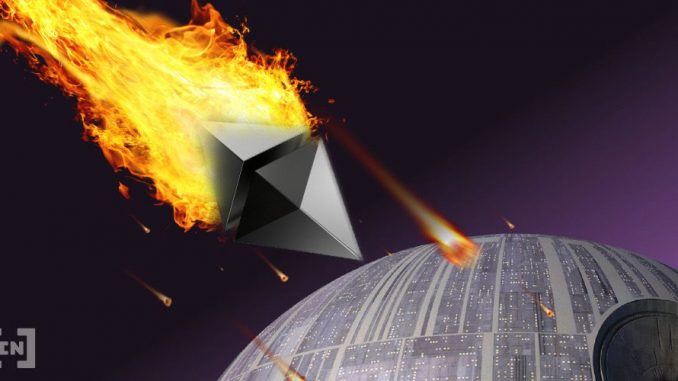
If 2020 was the year that ether (ETH) outperformed everything, then 2021 may be the year of Ethereum Layer-2 Solutions. So which Layer-2 solutions offer the best yield farming, and which ones might do an airdrop?
Why does Ethereum need Layer-2?
Ethereum’s network fees stink right now, and let’s face it, Ethereum has a gas problem. Though Ethereum 2.0 is years in the making and Beacon Chain has launched, the protocol has not grown fast enough to keep pace with its popularity. At best, Ethereum can still only handle about 30 transactions per second, and competition for a space has led to fees averaging over $15.
What’s more, a major driving force behind ETH’s growth is decentralized finance (DeFi). Whether lending, borrowing, or decentralized exchanging, users pay a heavy premium to use the world’s largest smart contract system. It makes sense: the tech works, it has a huge core of developers, and its security is time-tested.
But one of the points of blockchain is to whip fast payments around the world for pennies, right? So while Ethereum 2.0 won’t be flipping transactions instantly to at least December 2021, some clever devs have come up with some clever solutions: Layer-2.
How Layer-2 solutions work
Layer-2 solutions vary in function and purpose, but the basic premise is the same — a faster copy of the Ethereum network where users can upload their funds, do their business fast and for less than a penny, and then withdraw.
So if Layer-2 is so fast and cheap, why isn’t everyone already using it? Well, the fact is that you still need to deposit or exchange ETH or ERC-20 tokens just to get on the systems, and that still costs high fees. Plus, the exchanges don’t have the liquidity or variety that regular Ethereum-based exchanges have.
A number of Layer-2 solutions have arisen recently, especially those connected to Uniswap-style Automatic Market Makers (AMMs). So can Layer-2 may save Ethereum for the short term.
So what Layer-2 solutions might airdrop tokens?
Perhaps a more important questions is “How can I use Layer-2 solutions to make money?” Will these new AMMs do a Uniswap-style airdrop? Here are three Layer-2 solutions to watch out for, and maybe interact with.
Loopring (LRC) and the Loopring exchange
Maybe the Uniswap moonshot boom is dwindling down, but AMMs are here to stay. But fees for using Uniswap, with unlocking tokens in addition to swaps, are astronomical and people are getting turned off.
But what if you could swap without all those fees? What if a more traditional-style exchange was built in?
Loopring (LRC) has been around for over 2 years now, and now with Loopring Protocol Version 3 out, its token has boomed. Loopring essentially has users upload ETH to the exchange. Then, they can swap or trade their ERC-20 crypto assets on the Layer-2 for a fraction of the price as on Uniswap, and nearly instantly.
How do they do it? Loopring uses “zkrollups” to batch process transactions off-chain. Basically, transactions are settled on Loopring’s system, and then periodically the balances can be put through the Ethereum chain.
Total value locked in Loopring exploded in 2021, according to DeFi Pulse:
Right now, Loopring is also offering some nice liquidity mining rates. They were so good, in fact, that they were overwhelmed with deposits and the website actually shut down.
So, Loopring has a coin already, and they are doing yield farming. The LRC coin is useful for collecting a share a of transaction fees when staked.
But LRC is not a governance token. And what were 1inch and Uniswap’s aidrops? Governance tokens. So there is still a chance they could airdrop for users yet.
dHedge and Synthetix
Have you ever wanted to know if your favorite crypto influencer was actually making the money they say they were? Well, dHedge (DHT) allows users to pool their assets together with traders.
dHedge uses the Synthetix Layer-2 protocol to make synthetic assets which track the pools of different traders in a decentralized manner. Users deposit sUSD — via synthetix — and pools trade at their will.
Pretty cool, right? Yes… coolish. While some say the vast majority of day traders lose money, it is hard to say for sure. What is for sure is that almost none of the portfolios on dHedge have done much better than buying and hodling ETH and bitcoin (BTC). In fact, most of them have only three assets: ETH, BTC, and USD. Everyone is a genius in a bull market, right?
The dHedge token is rewarded to liquidity providers or even those who invest in top-performing assets. It is also a governance token. So what are the chances of an airdrop?
Using Synthetix to tokenize pools is clever, and if Synthetix can pull off a decent transition to a new Layer-2 solution, the protocol could see even more value locked than the current $1.82 billion.
Driving traffic and crypto to Synthetix and dHedge would be a good way to make users aware of a Layer-2 implementation. Heck, someone might even consider giving away free tokens to spread the word.
Anyway, dHedge explicitly states that DHT is not for speculation, but for governance, so you definitely would not want hodl dHedge to make money. Or would you?
Optimistic Rollups and Synthetix
Founded in January 2020, Optimism is an organization devoted to scaling Ethereum. Once known as Plasma Group, Optimism also uses Synthetix to achieve its aims.
Optimism is also doing rollups like Loopring (known as Optimistic Rollups), but has dropped some hints about a token. Their documentation says that anyone can become an aggregator, but does not mention how.
How then? Probably by a governance token. One that has not yet been released to the public. This makes Optimism ripe for an airdrop.
The evidence: Optimism has said in the past that they do not yet have a plan for a token.
From a Medium post on Jan. 1, 2021, the team mentions something that might come in a later January post that will discuss, “a path to decentralization.” What might be included in this post? Something decentralizing? Something about a governance token, perhaps?
Optimism will also offer stakers the opportunity to deposit or bond via smart contract. Essentially, aggregators — stakers — with a good history of honesty will be rewarded with a token. This bonding token and the reward was thought to be ethereum.
This “bonding” greatly reduces the amount of hashing to confirm a transaction since historically honest nodes are trusted more.
So maybe there is an Optimism token on the way.
We’ll have to wait and see. As Optimistic Rollups are not fully rolled out or used by any exchange, it is not clear how one would interact with Optimism to get free tokens.
However, Synthetix Mintr L2 testnet does allow you to play around with staking or minting tokens. It gets a bit complicated, but if you are interested, DeFi Dad did a nice video describing the process:
Following other airdrops’ success
Layer-2 solutions are going to come in 2021 to smooth out the wrinkles of Ethereum’s overworked and overpaid virtual machine. With the recent success of other airdrops, tokens might be the way traffic and value is driven to these new protocols.
But 2021 is also said to be the year of non-fungible tokens (NFTs). How will different NFT providers get users to their site (after Layer-2 has made the fees cheap, of course)? That’s something to explore for a different day.
NOTE: The views expressed here are those of the author’s and do not necessarily represent or reflect the views of BeInCrypto.
Disclaimer
All the information contained on our website is published in good faith and for general information purposes only. Any action the reader takes upon the information found on our website is strictly at their own risk.






Be the first to comment